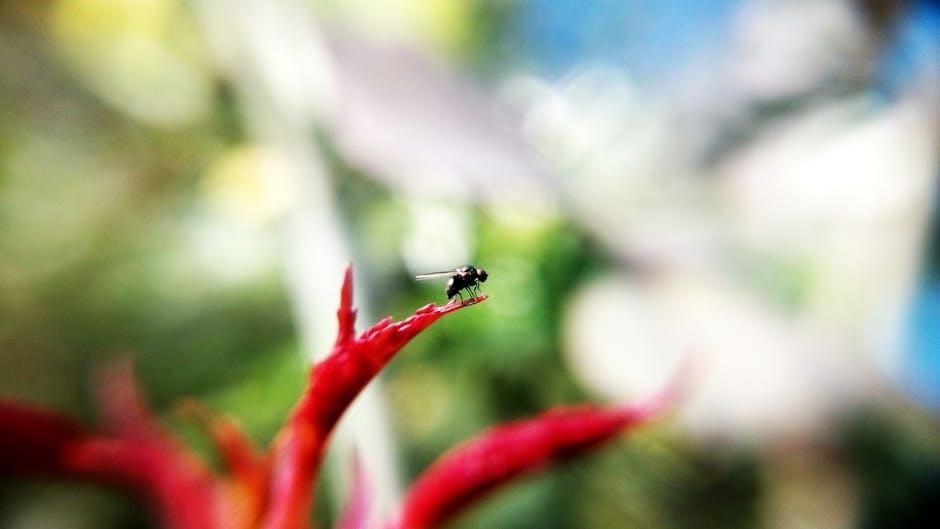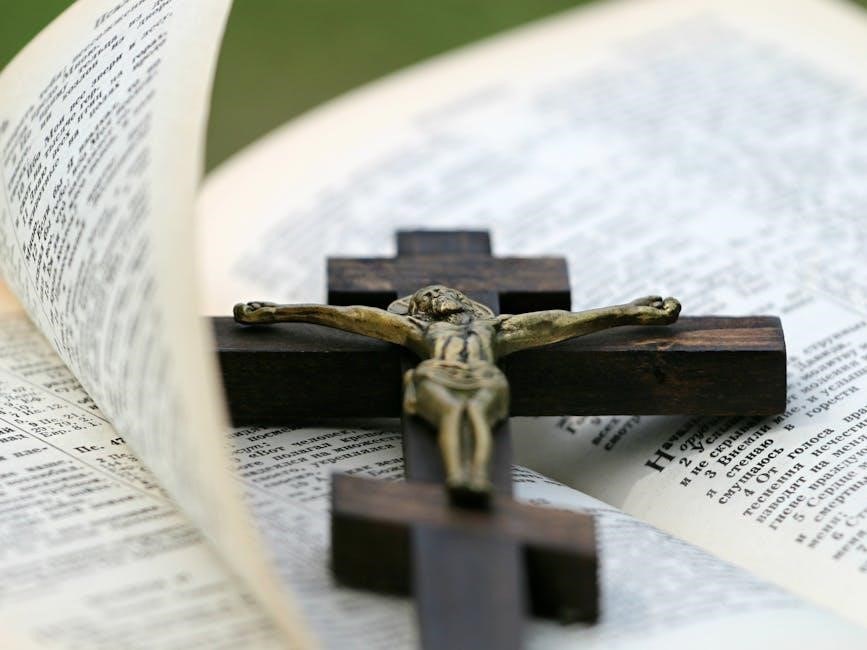William Golding’s Lord of the Flies explores human nature through boys stranded on an island, revealing themes of civilization, savagery, and societal collapse․ This PDF study guide provides chapter summaries, character analysis, and thematic insights․

Themes in Lord of the Flies
William Golding’s novel explores the nature of humanity, civilization vs․ savagery, the role of power, and fear’s consequences, revealing society’s fragility and human darkness․
The Nature of Humanity
William Golding’s Lord of the Flies explores the inherent duality of human nature, revealing how primal instincts emerge when societal constraints are removed․ The novel acts as a mirror, reflecting humanity’s capacity for both good and evil․ Through the boys’ descent into savagery, Golding illustrates the fragility of civilization and the darkness lurking within every individual․ This theme underscores the idea that human beings are inherently flawed, prone to greed, violence, and moral decay when left unchecked․ The island serves as a microcosm, exposing the raw, untamed aspects of human behavior․
Civilization vs․ Savagery
In Lord of the Flies, the struggle between civilization and savagery is a central theme․ The boys’ initial attempt to create a structured society, symbolized by the conch shell, gradually unravels as primal instincts take over․ The hunt for pigs and the fear of the “beast” represent the descent into savagery, while Ralph’s efforts to maintain order embody the fading grip of civilization․ Golding uses this conflict to illustrate how quickly humanity can revert to its baser instincts when external controls are removed, revealing the thin line between order and chaos․
The Role of Power
In Lord of the Flies, power dynamics significantly influence the boys’ behavior․ Ralph, elected as leader, initially embodies authority through fairness and democracy․ However, Jack’s desire for control shifts the balance, as he exploits fear and violence to gain dominance․ The struggle between Ralph’s democratic ideals and Jack’s authoritarian rule highlights how power can corrupt individuals and undermine collective stability․ Golding examines how the pursuit of power leads to moral decay, emphasizing its destructive nature when unchecked by societal norms or ethical constraints․
Fear and Its Consequences
Fear plays a central role in Lord of the Flies, driving the boys’ actions and decisions․ The mysterious “beast” sparks paranoia, causing the group to fracture․ As fear intensifies, it leads to irrational behavior, violence, and the breakdown of their makeshift society․ Ralph and Jack’s differing responses to fear—Ralph seeking rational solutions, Jack exploiting it for control—highlight how fear can both unite and divide․ Golding illustrates how unchecked fear erodes morality, leading to chaos and the boys’ descent into savagery, ultimately revealing the darker aspects of human nature when fear dominates․

Key Characters Analysis
The novel focuses on Ralph, Jack, Piggy, and Simon, each embodying distinct traits․ Ralph leads with reason, Jack craves power, Piggy symbolizes wisdom, and Simon seeks truth․
Ralph: The Natural Leader
Ralph, the protagonist, emerges as a natural leader with charisma and athleticism․ He initially embodies democracy and order, using the conch shell to maintain civility․ His leadership emphasizes building shelters and maintaining a signal fire, reflecting his practicality and concern for the group’s safety․ However, as the novel progresses, Ralph’s leadership is challenged by Jack’s desire for power, leading to internal conflict and the erosion of his authority․ Despite this, Ralph remains a symbol of hope and the possibility of civilized behavior;

Jack Merridew: The Hunter
Jack Merridew, the choir leader, evolves from a disciplined boy into a power-hungry hunter․ His obsession with hunting symbolizes his primal instincts and desire for control․ Jack’s leadership challenges Ralph’s authority, leading to a rift among the boys․ His descent into savagery is marked by his painted face and the formation of his own tribe․ Jack’s actions, including the hunt for the “beast” and his role in Simon’s death, highlight his ruthless ambition and the collapse of civilized behavior on the island․
Piggy: The Voice of Reason
Piggy, the intelligent and rational character, struggles with his physical limitations due to asthma and weight․ Despite being an outcast, his wisdom and logical thinking are vital․ He relies on the conch shell to maintain order and advocate for democracy․ Piggy’s deep understanding of human nature and loyalty to Ralph highlight his importance․ However, his lack of physical strength makes him vulnerable․ His ideas, such as using the conch for fairness, emphasize his belief in rules․ Tragically, his voice of reason is silenced, symbolizing the loss of wisdom and civility․
Simon: The Truth Seeker
Simon, the quiet and introspective boy, is the first to discover the truth about the “beast․” He realizes it is a dead parachutist, not a monster․ His unique perspective and sensitivity set him apart․ Simon’s tragic death occurs when, in a frenzy, the boys mistake him for the beast․ His death symbolizes the loss of innocence and reason, as he was the only one who understood the true nature of their fears․ Simon’s character represents wisdom and the search for truth in a world descending into chaos․
Symbols in the Novel
The novel is rich in symbols, such as the conch shell representing order, the beast embodying fear, and the Lord of the Flies symbolizing evil․
The Conch Shell: Order and Democracy
The conch shell is a powerful symbol of order and democracy in Lord of the Flies․ Found by Piggy, it is used to summon meetings and ensure each boy speaks in turn․ The shell represents civility and the democratic process, allowing the boys to maintain structure․ However, as the novel progresses, the shell loses its power, reflecting the decline of their societal norms․ This symbol highlights how fragile order is without strong leadership and shared values, central to Golding’s exploration of humanity․
The Beast: Fear and Paranoia
The “beast” in Lord of the Flies symbolizes primal fear and paranoia․ Initially, the boys believe it is a mysterious creature on the island, creating widespread terror․ The beast becomes a tool for Jack to manipulate the group, exploiting their fears to gain power․ As the novel progresses, the beast evolves into a symbol of the boys’ inner savagery․ The true nature of the beast—a dead pilot—is eventually revealed, but the damage is done, as fear has already led to chaos and division among the group, highlighting Golding’s exploration of human frailty․
The Lord of the Flies: Evil Incarnate
The “Lord of the Flies,” a pig’s head impaled on a stake, symbolizes pure evil and corruption․ It appears after Simon discovers the truth about the “beast,” revealing the true nature of the boys’ savagery․ The pig’s head, infested with flies, represents the decay of innocence and moral values․ Jack’s offering of the head to the beast signifies his embrace of darkness and the group’s descent into chaos․ This powerful symbol underscores Golding’s theme that evil is inherent in humanity, emerging when societal constraints are removed․

Study Guide Resources
Download comprehensive study guides for Lord of the Flies, featuring chapter summaries, essay prompts, and character analysis to deepen your understanding of the novel’s themes and symbolism․
Chapter Summaries and Analysis
The PDF study guide offers detailed chapter summaries and analysis, exploring themes like civilization vs․ savagery and leadership․ Each chapter is broken down to highlight key events, character development, and symbolic elements․ From Ralph’s leadership struggles to Jack’s descent into savagery, the guide provides insights into how Golding crafts a gripping narrative․ Analysis of major plot points, such as the discovery of the conch shell and the beast, reveals deeper meanings․ This resource is essential for understanding the novel’s layered themes and character arcs, making it a valuable tool for students and readers alike․
Character Analysis and Themes
The PDF study guide delves into the complexities of characters like Ralph, Jack, Piggy, and Simon, analyzing their roles in exploring themes of power, fear, and morality․ It examines how Ralph represents order, while Jack embodies primal instincts․ Themes such as civilization vs․ savagery and the effects of fear are explored in depth, connecting character actions to broader societal implications․ The guide provides detailed insights into how Golding uses these elements to critique human nature, making it an invaluable resource for understanding the novel’s profound themes and character dynamics․
Essay Prompts and Discussion Questions
The PDF study guide offers a range of essay prompts and discussion questions to deepen understanding of Lord of the Flies․ Questions explore themes like leadership, morality, and fear, prompting analysis of characters and their decisions․ Topics include the impact of fear on group dynamics, the symbolism of the conch shell, and the novel’s commentary on human nature․ These prompts encourage critical thinking and connections between the novel’s events and real-world societal issues, fostering meaningful debates and written reflections on Golding’s timeless themes․
Psychological and Sociological Analysis
The novel explores the breakdown of social norms and the rise of primal instincts, offering insights into human behavior through Freudian psychology and group dynamics․
Freudian Psychology in the Novel
The novel aligns with Freudian psychology, where the boys’ behavior reflects the struggle between the id, ego, and superego․ Jack’s primal desires (id) clash with Ralph’s rational leadership (ego), while Piggy’s moral reasoning (superego) fades․ The conch shell symbolizes civilized order, contrasting with the beast, which embodies unconscious fear․ Golding’s portrayal of societal collapse mirrors Freud’s theory of civilization suppressing instincts, highlighting humanity’s innate savagery when unchecked․ This psychoanalytic lens reveals the boys’ descent into chaos, driven by internal and external conflicts․
Social Dynamics Among the Boys
The novel portrays the boys’ social dynamics as a microcosm of society, revealing power struggles and group behavior․ Initially, Ralph’s democratic leadership unites the group, but Jack’s desire for control sparks division․ Fear of the “beast” escalates paranoia, leading to mob mentality and tribal splits․ The boys’ interactions reflect societal hierarchies, with Piggy’s exclusion highlighting marginalization․ Golding shows how quickly social norms collapse without authority, as the boys’ behavior shifts from cooperation to savagery, mirroring human nature’s primal instincts and the effects of unchecked power dynamics․
